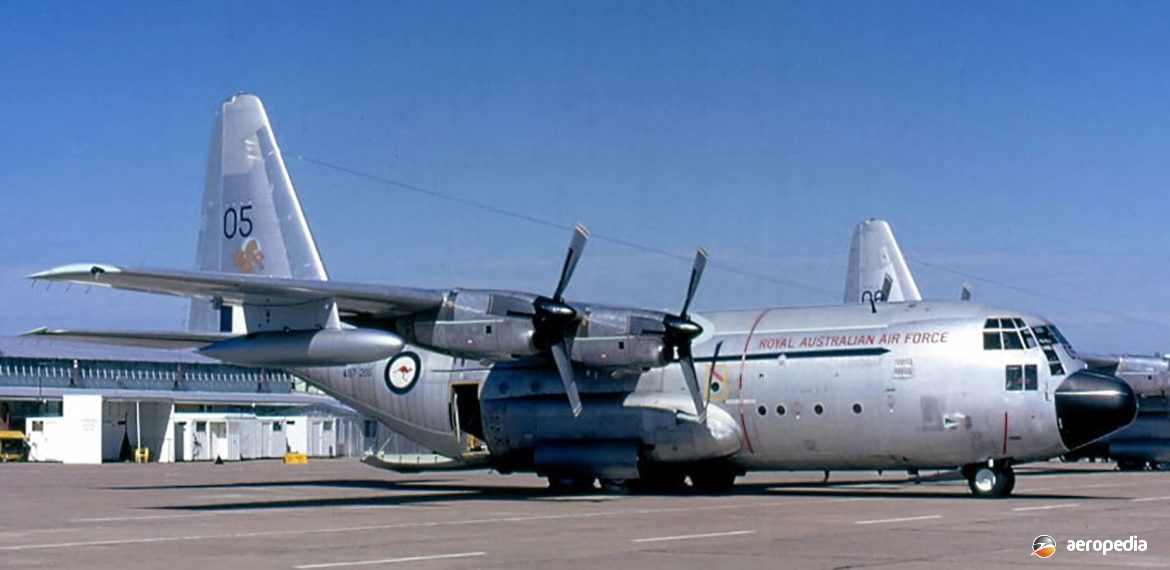Photograph:
Lockheed C-130A Hercules A97-205 at RAAF Richmond, NSW (David C Eyre)
Country of origin:
United States of America
Description:
Military tactical transport
Power Plant:
Four 2,797 kw (3,750 eshp) Allison T56-A-11 turboprops
Specifications:
- Wingspan: 40.25 m (132 ft 7 in)
- Length: 29.78 m (97 ft 9 in)
- Height: 11.68 m (38 ft 4 in)
- Wing area: 162.11 m² (1,745 sq ft)
- Max cruising speed: 580 km/h (360 mph)
- Rate of climb at sea level at 45,360 kg (100,000 lb): 730 m/min (2,400 ft/min)
- Service ceiling: 10,360 m (34,000 ft)
- Take-off distance to 15 m (50 ft) at 56,335 kg (124,000 lb): 1,135 m (3,720 ft)
- Landing distance from 15 m (50 ft) at 45,360 kg (100,000 lb): 685 m (2,250 ft)
- Range with 16,600 kg (36,000 lb) payload at 539 km/h (335 mph): 2,945 km (1,830 miles)
- Range with max internal fuel: 4,440 km (2,760 miles)
- Max range with two 1,705 litre (375 Imp gal) pylon tanks and 9,200 kg (20,500 lb) payload: 5,390 kg (3,350 miles)
- Empty weight: 28,576 kg (63,000 lb)
- Max payload weight: 16,600 kg (36,600 lb)
- Loaded: 56,340 kg (124,200 lb)
History:
The most successful large military transport in the Western inventory, with more than 2,000 examples built in a variety of versions, the Hercules continues in production in the C-130J variant. The first of two YC-130 prototypes was flown on 23 August 1954 and subsequently production commenced at the Lockheed Georgia, Marietta facility, where the first production model, the C-130A, was flown on 7 April 1955. Lockheed’s Model 382, named after the Greek hero Heracles, was designed in answer to a USAAF requirement in 1951 for a fleet of turboprop transports to be used by Military Airlift Command and Tactical Air Command. An initial contract was placed on 11 July 1951, the first production contract being awarded in September 1952, deliveries from the Company’s Marietta, Georgia plant commencing in December 1956.
A total of 219 C-130As was built for the USAF, and 12 (A97-205 to A97-216) were delivered to the RAAF. The Australian machines were fitted with 2,797 kw (3,750 eshp) Allison T56-A-11 turboprops, and the first was delivered to the RAAF on 8 November 1958, replacing Douglas C-47 Dakotas with No 36 Squadron based at Richmond, NSW. The C-130As were later replaced.
The Hercules has seen RAAF service for over fifty years. No aircraft has been lost, or involved in any major accident. When withdrawn from service in 1978, the C-130As had flown 145,000 hours, or an average of 12,800 hours per aircraft, an annual utilisation of 640 hours. For a period the C-130As, after retirement, were stored at Laverton, VIC. Some were allotted US registrations and were said to be sold overseas, a few leaving but others never leaving Australia.
A number received overseas registrations but did not leave. Their histories are as follows: A97-205 (c/n 3205) received the registration N22660 but this was not taken up; then N205FA but the fuselage eventually ended up at Holsworthy army barracks, NSW for training. A97-206 (c/n 3206) was allotted N22669 but it was not taken up. It was registered RP-C3206 in July 1988 but was broken up for parts in November 1993.
A97-207 (c/n 3207) was registered N22FV. The Australian Government then donated the aircraft to the Red Cross to carry out relief work in Ethiopia as EL-ALM. It eventually became N207GM but was broken up in September 2001. A97-208 (c/n 3208) was allotted N2267N, then painted as HK-3017X, and later SH-3017. It was sold to the French Government and became N4445V, later becoming TT-PAA in 1983 with Chad Air, and went to France where it was broken up. A97-209 (c/n 3209) was used for Loadmaster training at RAAF Richmond but was destroyed in a storm on 3 December 2001.
A97-210 (c/n 3210) became N2267U but this was not taken up. It then became N12FV, later becoming RP-C3210 in the Philippines, but was broken up for parts in November 1998. A97-211 (c/n 82-3211 – ex 57-0504) ended up at RAAF Wagga as a training aid. It was registered N5394L. In July 1988 it went to the Philippines as RP-C3211 but was broken up for spare parts, these being shipped to the United States.
A97-212 (c/n 3212) received registrations N2268A, HK-3016X, SH-3016, N13FV, N213DW and eventually ended up as a skydiving aircraft in the US at Rantoul, Illinois during the World Freefall Convention as N131EC. A97-213 (c/n 3213) was registered N2268G but this was not taken up. It then became RP-C3213 and was broken up for parts in January 1995.
A97-214 (c/n 3214) was allotted N2268N but it was not taken up. It was conveyed to the RAAF Museum at Point Cook where it was placed on display. However, it there suffered from corrosion problems being in a sea environment. A97-215 (c/n 3215) was allotted N2268V but the registration was not taken up. It became N4469P in October 1983 and was broken up for parts in December 1997 at Fort Lauderdale, Florida. A97-216 (c/n 3216) was allotted N2268W, later HK-3017X, but its sale to Columbia was vetoed by the US Government. It became N15FV, later N216CR, and in March 1993 was flown to Lockheed and placed in storage until scrapped in September 2001.
In the late 1980s 22 retired USAF C-130As were removed from storage at Davis Monthan Airbase. Aircaft A97-214 after operating with RAAF No 36 Squadron, part of No 86 (Tansport) Wing, after supporting RAAF forces in Thailand and Vietnam, and providing relief to Darwin following Cyclone Tracy in 1974 was placed in open storage at RAAF Base Laverton it was transported to Point Cook in May 1974. Suffering major corrosion problems, the aircraft has been dismantled and the fuselage nose section has been conveyed to the National Vietnam Veterans Mueum (NVVM) in Victoria where it will be restored for display.

